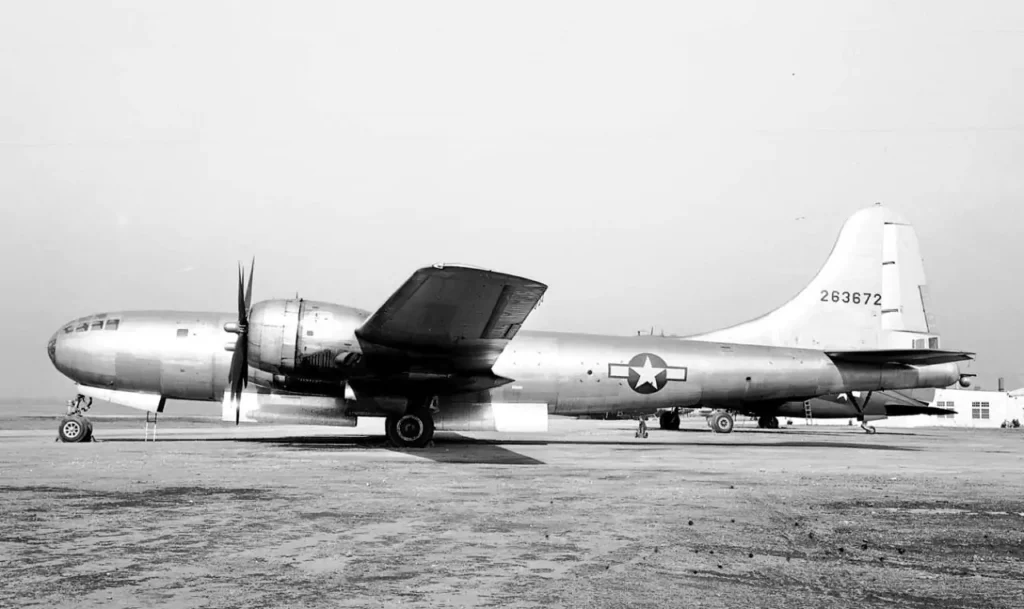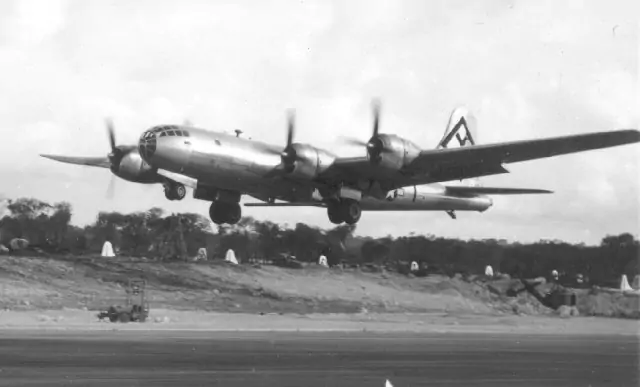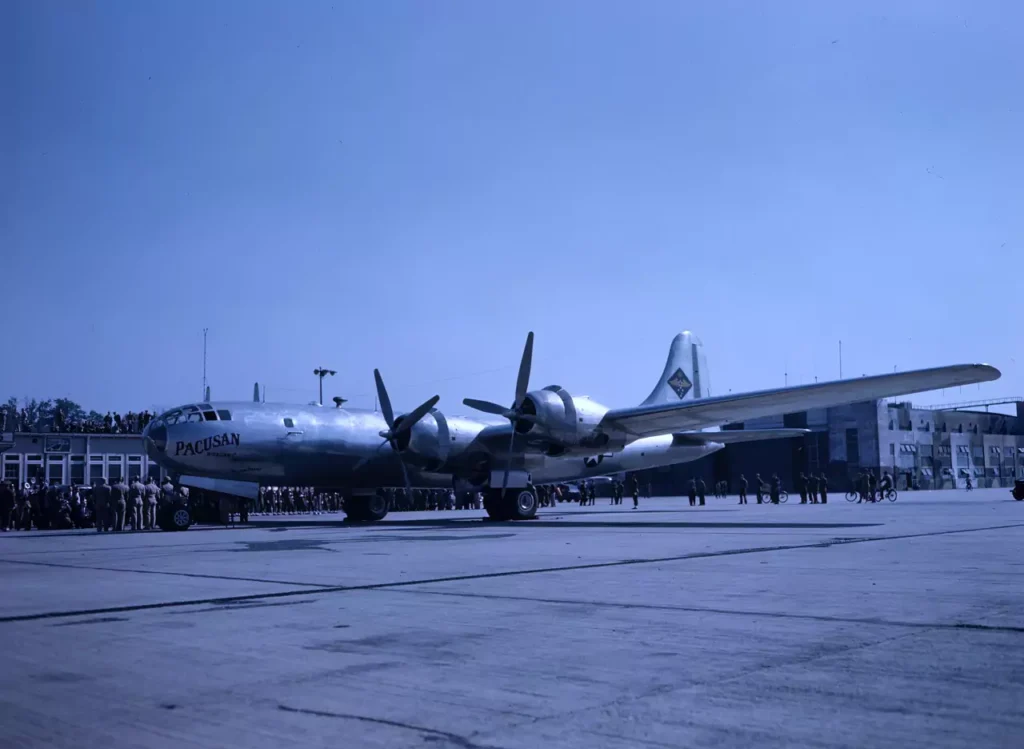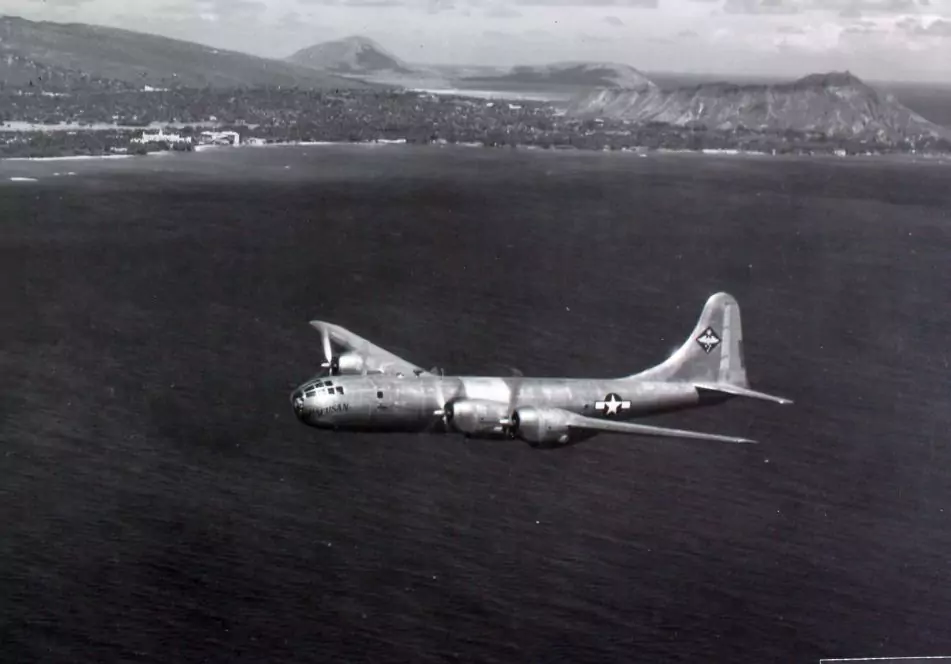Introduction
The Boeing B-29B was a simplified, lighter Superfortress. It didn’t have the upper and lower gun turrets but kept a modified tail turret. All other guns and extra equipment were removed, making it look sleek and easy to recognize. The B-29B was designed for bombing at night, using the advanced APQ-7 Eagle and AN/APG-15 radar systems. This simpler model was only built by Bell-Atlanta.
Production
From January to September 1945, the Bell-Marietta factory made 311 B-29B planes. This was a modified version of the Boeing B-29 Superfortress. The planes were built in small batches or sometimes individually, and all had the Boeing Model 345-3-0 label.
At first, Bell had problems with production. So, the early B-29Bs were sent without electronic gear to the Oklahoma City Air Depot. From February to May 1945, electronic equipment was installed there. By May, Bell had resolved the issues and began making complete planes.
Most of these planes were sent to XXI Bomber Command’s 315th Bombardment Wing at Guam. This group started operations on April 1, 1945. They specialized in low-altitude nighttime missions, which were very effective against the Japanese oil industry.
All this happened at Bell’s plant in Marietta, Georgia. Later, the Lockheed-Georgia Company used this plant. In total, Bell built 668 B-29s there, including the 311 lighter B-29Bs.
Differences with B-29
Identifying B-29Bs from regular B-29s that had their gun turrets removed for weight saving during the 1945 firebombing of Japan can be tricky. Yet, they can be recognized through their unique serial numbers and a specific external radar antenna at the tail’s extreme end.
Internally, the B-29B had the following several differences compared with a standard B-29:
Engines
Four Wright R-3350-51 engines powered the B-29B. To improve cooling, engineers made adjustments to the engine baffles and added vents to the turbo supercharger covers. Additionally, the pilots’ throttle override controls were removed.
Electronic Equipment
The B-29Bs saw major updates in their radio and electrical systems. Several components like the AN/ARR-1 homing adapter, SCR-718 radio altimeter, SCR-729 interrogator, some parts of the SCR-274-N command radio, the complete aft “Raven” station, frequency meter, search antennas, and cables, and the AN/APQ-13 radar were all removed. Additionally, they got an aerodynamic boost with newly designed static dischargers to lessen drag.
An/APQ-7 Eagle
In the B-29Bs, the AN/APQ-13 radar was replaced with the more advanced AN/APQ-7 Eagle unit. This required the radar operator to move from the rear to the front compartment, right behind the navigator, and across from the radio operator. Unlike the previous setup, there was no AN/APQ-7 repeater for the navigator.

The new radar featured a 16ft streamlined vane scanner, known as the ‘Eagle Wing’ antenna, mounted under the fuselage. This contained an array of 250 dipoles along its leading edge, which were fed by a waveguide with adjustable width.
The system operated at a wavelength of around 3cm, creating a beam width of approximately 0.4° to 0.5° in azimuth and about 30° in elevation. The beam was electronically scanned 30° left and right by adjusting the waveguide width. This narrower beam led to a 60° sector presented on the scope, delivering superior radar return definition.

From the outside, the radar installation was identifiable by an 18-foot wide, airfoil-shaped wing antenna hanging between the bomb bays. Despite the rigorous operational readiness requirements for the B-29B, some equipment like the AN/APG-15 gun laying radar, IFF, GE computer tie-in equipment, third tail gun, and waist guns were exempted to avoid any overseas movement delays.
The aircraft were destined for the 315th Bomb Wing. The 16th and 501st Bomb Groups were set to be operationally ready by 1 April 1945, followed by the 502nd and 331st Bomb Groups on 1 May 1945. To keep up with these schedules, radar operators received training on B-24s equipped with the Eagle radar.
However, post World War II, the Eagle radar was removed from all operational B-29s.
Armament
The Boeing B-29B underwent significant modifications in its armament. All four fuselage turrets and associated equipment were removed, leaving only the two tail guns intact. This change was due to the limited Japanese fighter opposition at the time, which predominantly attacked from the rear.
To further streamline the aircraft, smooth coverings were installed over the vacant turret and sight openings. The 20mm tail cannon was removed, and in its place, a third .50 caliber machine gun was added, along with expanded ammunition provisions.
In addition, removable turret structures, armor, and flak protection, except for the dural plate behind the pilots’ position, were all removed. Armor and glass located after the tail gunner were also taken out, but the glass forward of the pilot’s position remained.

Furthermore, stowable .50 caliber machine guns were added together with the AN/APG-15 gun-laying radar described in the next section.
The AN/APG-15B radar
The Boeing B-29B featured an innovative tail gun system. This was driven by the newly introduced AN/APG-15B radar fire control system, which was connected to the General Electric gun computer and the Identification Friend or Foe (IFF) units, also known as “Ella”.
This advanced radar system could detect an approaching enemy aircraft and automatically carry out the necessary calculations to track and fire at it. However, the AN/APG-15B system proved to be challenging and ineffective in the field, leading to its removal from most aircraft.
Other modifications
All G-1 pressure signals and warning lights were removed, along with one oxygen regulator for the tail gunner, sleeping bunks and belts at auxiliary crew stations, and the bombardier’s table. Other eliminations included the B-5 drift sight, engine covers, storage boxes for wiring diagrams, oblique camera installations, and deicer boots, although provisions for these were retained.
Crew
The B-29B was typically operated by a smaller crew of seven to eight members due to the decreased need for gunners. This reduced crew usually included the commander, pilot, navigator, radar operator, bombardier, radio operator, flight engineer, and tail gunner. The central fire control gunner often took on the role of an observer, and the bombardier’s tasks could generally be handled by the radar operator.
Despite the streamlined crew size, the aircraft occasionally accommodated up to ten individuals. The two additional members served as scanners, tasked with identifying both allied and enemy aircraft during operations
Performance
By removing the turrets, guns, blisters, and the General Electric computerized gun system, the weight of the aircraft was substantially reduced. This reduction in weight, along with the sleeker profile of the aircraft, contributed to an increase in top speed to 364mph at an altitude of 25,000 feet.
These improvements allowed the B-29B to perform unescorted “hit-and-run” bombing raids and photo-reconnaissance missions more efficiently. Furthermore, the weight saved from the removal of defensive armament was predominantly used to increase the bomber’s bomb capacity, thereby augmenting its offensive capabilities.
Given these significant enhancements, there was a strict insistence from LeMay, XXI Bomber Command commander, that these bombers be delivered to the Pacific without any delay. He maintained that no compromises in training and equipment should be allowed, with the only exceptions being the AN/APG-15 and its associated equipment, and the third tail machine gun.
Pacusan Dreamboat
In 1946, a Boeing B-29B known as the Pacusan Dreamboat, made some impressive achievements.
First, it traveled from Hawaii to Cairo in October, going over the North Pole, covering 9,444 miles. It took off with a gross weight of 147,000 pounds, which was over the maximum limit, and did it in 39 hours and 36 minutes.

The selected route was known for its tough winter climate and intricate navigation and communication issues.
Then, in November, it flew non-stop from Guam to Washington D.C. This was a trip of 7,196 miles completed in 35 hours, breaking a record that stood since 1938.
Finally, in December, the Dreamboat made a speedy trip from Burbank, California, to New York. It took just over 5 hours to cover 2,464 miles, reaching an average speed of 450.38 miles per hour. This set a new speed record for aircraft with multiple engines.
B-29B Specification
For technical details on the Boeing B-29B please read Boeing B-29B Superfortress Specifications (1950)
Further reading
Bibliography
- Boeing B-29 Superfortress (Crowood Aviation Series) by Steve Pace
- Boeing B-29 Superfortress: The Ultimate Look: From Drawing Board to VJ-Day by William Wolf
- B-29 Superfortress: Giant Bomber of World War Two and Korea by Graham M. Simons
- Boeing B-29 Superfortress Manual 1942-60 (all marks): An insight into the design, operation, maintenance and restoration of the USA’s giant long-range heavy bomber by Chris Howlett
- B-29 Superfortress in detail & scale, Part 1: Production Version by Alwyn T. Lloyd